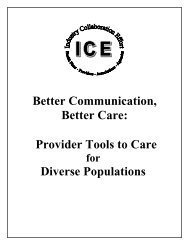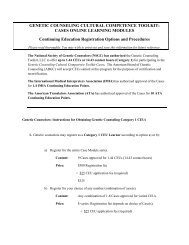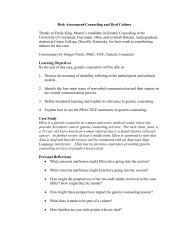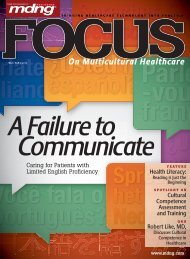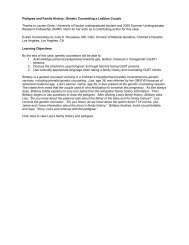Advanced Effective Communication, Cultural Competence, and ...
Advanced Effective Communication, Cultural Competence, and ...
Advanced Effective Communication, Cultural Competence, and ...
You also want an ePaper? Increase the reach of your titles
YUMPU automatically turns print PDFs into web optimized ePapers that Google loves.
A Roadmap for Hospitals<br />
Chapter Three: Treatment<br />
Figure 5-1. Sample Tool for <strong>Communication</strong> Assessment<br />
Patient <strong>Communication</strong> Assessment Tool<br />
Baseline <strong>Communication</strong> Method/Special Needs<br />
1) Verbal<br />
2) Writing (Pen & Paper)<br />
3) <strong>Communication</strong> Board<br />
4) Electronic <strong>Communication</strong> Device<br />
5) Speaking Valve<br />
6) Gesturing<br />
7) Mouthing/Lip Reading<br />
8) Hearing Aids<br />
9) Glasses<br />
10) Language Interpreter Needed<br />
11) Family Facilitated<br />
12) Sign Language Interpreter Needed<br />
13) Other (document explanation)<br />
Assessment<br />
Patient’s reported level of distress<br />
with communication [scale 0-5]<br />
0) Not at all<br />
1) A little bit<br />
2) Somewhat<br />
3) Quite a bit<br />
4) Very much<br />
5) No response<br />
Current Barriers<br />
1) Hostility<br />
2) Withdrawn/Depressed<br />
3) Delirium<br />
4) Agitation<br />
5) Confusion<br />
6) Impaired LOC*<br />
7) Illiterate<br />
8) Orally Intubated<br />
9) Trached<br />
10) Foreign Language<br />
11) Sedated<br />
12) Restrained<br />
13) Surgery<br />
14) History of Stroke<br />
15) Weakness<br />
16) Vision Impairment<br />
17) Hearing Impairment<br />
18) Visitation Restrictions<br />
19) Other (document explanation)<br />
20) None<br />
Interventions at Point of Care<br />
1) Comfort Measures<br />
2) Music<br />
3) Sitter<br />
4) <strong>Communication</strong> Device (document explanation)<br />
5) Phone<br />
6) Speaking Valve<br />
7) Calm Spoken Voice<br />
8) Give Patient Time to Communicate<br />
9) Released Restraints<br />
10) Glasses<br />
11) Hearing Aid<br />
12) Call Light<br />
13) Interpreter<br />
14) Other (document explanation)<br />
Re-Assessment<br />
Patient’s reported level of distress<br />
with communication [scale 0-5]<br />
0) Not at all<br />
1) A little bit<br />
2) Somewhat<br />
3) Quite a bit<br />
4) Very much<br />
5) No response<br />
Evaluation/<strong>Effective</strong>ness<br />
1) Patient reports being satisfied<br />
2) Family reports being satisfied<br />
3) Patient reports being unsatisfied<br />
4) Family reports being unsatisfied<br />
5) Patient responds appropriately with intervention<br />
6) Necessary information is obtained from <strong>and</strong> provided to<br />
the patient<br />
7) Patient demonstrates underst<strong>and</strong>ing<br />
8) Other (document explanation)<br />
Referral<br />
1) Yes (document explanation)<br />
2) No<br />
* LOC, level of consciousness<br />
Source: Modified from Patak L., et al.: Improving patient–provider communication: A call to action. J Nurs Adm Sep 2009; 39(9):372-376. Used with<br />
permission.<br />
Use an assessment tool to identify any changes in communication needs <strong>and</strong> include the results in any h<strong>and</strong>-off reports. This<br />
sample patient communication assessment tool was designed to be incorporated into computerized charting menus to help nurses<br />
select drop down items which corresponded to their patient communication assessment, intervention, <strong>and</strong> evaluation process.<br />
19



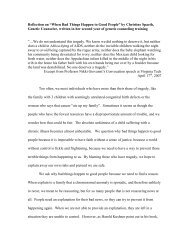
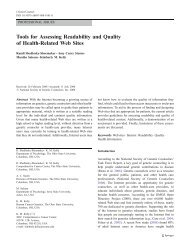

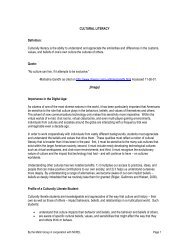


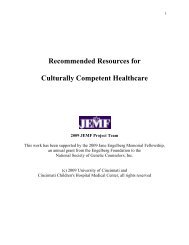

![Breaking Bad News PPT[1] - Genetic Counseling Cultural ...](https://img.yumpu.com/35003134/1/190x146/breaking-bad-news-ppt1-genetic-counseling-cultural-.jpg?quality=85)
